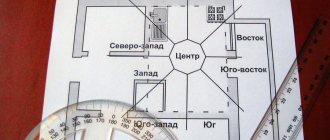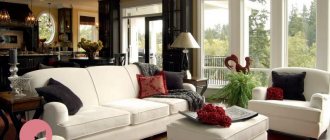Owners of private houses can provide themselves with a decent and happy life, improve family relationships, build a career, earn enough money, and also not complain about their own and their relatives’ health. It's not easy to have a roof over your head or realize the dream of owning your own home. Anyone who builds a country cottage is free to implement the project, taking into account all the rules and requirements of the ancient teachings of Feng Shui.
An example of the correct layout of a house according to Feng Shui
Private builders have much more opportunities to do everything according to ancient canons, unlike apartment owners. Initially, anyone who plans to move to live in the country can choose the right site, design it accordingly, calculate the location of the house according to Feng Shui and make a competent interior layout.
Feng Shui plot
A house in which Qi energy dominates, where harmony and peace reign, must be located in the correct energetic place. Therefore, the construction site must be selected carefully. The teaching of Feng Shui also dictates its own rules and requirements in this regard. If you have the opportunity to go live in the countryside, then it is better to do so. The location of your own home in a chaotically built-up city is the most unfavorable from the point of view of Feng Shui.
Feng Shui site layout with house location
A small house surrounded by high-rise buildings, or a low-rise private building that rings a modern center of high-rise buildings, are neighborhoods where Qi energy cannot circulate freely, but Sha energy, on the contrary, will constantly penetrate into the home.
The optimal location for the house would be a cottage community or other specialized area allocated for development. In such a place, neighboring houses not only have a similar number of storeys, but even a uniform design style, which will have a beneficial effect on energy flows.
If the site is located in a picturesque location, this will also play into the hands of the future owners of the house. Qi energy predominates in forests, parks, and natural areas. A small natural pond is also a good addition. However, the presence of forests or other green spaces should not greatly shade the site. The sun should be present in sufficient quantities on the building territory. Although constant sunshine is also unacceptable.
Correct location of objects on the site according to Feng Shui
The site should not be in a lowland. In general, the main principle for choosing a land plot is consistent harmony of the landscape. It doesn't have to be a bare field or endless hills. Everything should be in moderation. Only in this case will harmony be ensured in your home.
Location of the house on the site
The location of the house according to Feng Shui requires not only the correct determination of the cardinal directions, the correct direction where your positive energy comes from, but also compliance with other, more earthly characteristics. For example, if the building site is a corner one, then it would be a mistake to locate the house on the outer corner, next to the intersection of two roads. Qi energy avoids such places, but Sha will often be your guest. In this case, it is better to hide the house deep into the site, separating it from the intersection with a fence reinforced with Feng Shui.
A nearby pond is an excellent addition to the site, but water imposes certain requirements on the location of the house. In particular, it is better to install it with the central facade facing the pond. If this is not possible, and the lake or pond is in the rear of the building, then it is necessary to strengthen the position of the house by fencing it off.
The house on the site cannot be located strictly in the center. The building, surrounded by emptiness, has no support, protection or support.
Living in such a house will be very difficult, especially building serious relationships, raising children and solving some important problems.
It is better to move the house to the side of the site that is favorable for you, but not close to the fence. There must be sufficient distance between the house and the fence. The fence should not be very high; this rule is especially important when constructing a one-story building. In this case, it will be difficult for Qi energy to penetrate inside, but negative energy flows will stagnate on your territory for a long time.
An example of the location of a house according to the cardinal directions according to Feng Shui
When a house is built on a plot, the territory must be formalized. This applies to absolutely everything, from outlines and defining boundaries to landscape design. Abandonment and chaos on the ground around the house will scare away favorable energy and create good conditions for Sha energy. However, when laying out flower beds and flower beds, you must remember that the central door of a private house should remain as open as possible, unobstructed. Only in this way will constant flows of Qi be able to freely penetrate the building.
The path leading from the house to the exit to the street should not be straight. It is advisable to make it sinuous, with smooth rounded bends. If this is not possible due to the limited size of the site and territory, then you need to try to make sure that it does not immediately abut the fence and gate.
Conduct an audit of each zone
Now walk through the rooms and carefully examine each area. Identify the most “affected” areas. Which area is the most cluttered? Which one requires immediate cleaning? Which area will you need to pay the most attention to?
Also make a note for yourself which zone is currently most relevant to you personally. If you have been trying to have a child for a long time, then you will have to make special efforts in the Children zone. If you can’t find a job, put an exclamation point in the Career zone. I think the principle is clear.
Location of the house on the site relative to the cardinal directions
There is a general recommendation: the successful location of a country house on a site relative to the cardinal directions will be such that the central façade faces south, and the opposite façade faces north. But in reality, everything is not so simple. The teachings of Feng Shui do not give average advice, which, if followed, will be good for everyone.
The orientation of the house on the site requires an individual approach, since the personal characteristics of all people living in the building must be taken into account.
According to Feng Shui, the cardinal direction is a source of energy responsible for a certain area of our life. Accordingly, the house must be oriented taking into account the dominant areas.
Energy enters the house through the front door and windows. This means that the central facade and entrance should be oriented towards the side of the world whose energy you lack or need.
- East - will bring fresh ideas, help in any endeavors, give strength to solve non-trivial problems;
- The south is active energy, it will stir up all household members, fill the house with life and movement, and help bring all the things started to completion. Guests often come to such a house; something is constantly happening here;
- The West is the passive energy of results and conclusions; it will perfectly help you understand any complex matter, become more successful in business, and a good specialist in your field. You can avoid constantly recurring negative situations with the help of Western energy;
- North is the energy of self-knowledge; it will help you establish contact with yourself, promote a calm, secluded lifestyle, support philosophical moods, help you interpret what is happening, and remain alone with yourself.
In addition to pure energy, there are mixed flows, if you orient your house not strictly to the south, but to the southeast or south-southeast.
Table of sectors and zones of Feng Shui with the location of energy in them
Also, using different Feng Shui tools, you can increase or decrease the penetration of necessary or unwanted energy into your home.
Feng Shui house layout using a bagua grid
It’s easier to plan correctly once than to correct mistakes for a long time. It is this rule that best reflects the essence of house planning according to Feng Shui. The main tool in this matter is the bagua square.
What is a bagua grid
The bagua square is initially not a square at all, but an octagon with a functional center. Otherwise, it is an energy map with which you can determine energy flows in any room. All its sectors are different aspects of human life:
- wealth;
- glory;
- marriage, relationships;
- health;
- family;
- children, creativity;
- knowledge, wisdom;
- career;
- vacation, travel.
Each sector is characterized by its own direction, as well as tools that allow one to strengthen or neutralize the energy coming from this direction.
The classic octagon-shaped Bagua grid is quite complex for non-professional Feng Shui consultants. In order for the basics of the ancient teaching to be accessible to everyone, it was presented in the form of a Lo-Shu square, each sector-cell of which corresponds to a sector of the octagon.
Correct application of bagua
Applying a bagua to the drawing and design of the cottage will help determine how correctly the layout of your private home is done. If the house has not yet been built, then it will be much easier to make adjustments or completely redesign the internal structure of the house. In order to correctly apply the bagua grid to a house project, you will need a drawing of it.
An example of applying a bagua grid to a house layout
If the breakdown has already been carried out, then after a detailed study it will be possible to make adjustments; if the country house is an empty box without internal partitions, then you can make the layout yourself, dividing the space into internal rooms.
Private rooms
If necessary, all of the above can be applied to very small areas: a room or even a table! It’s not for nothing that almost all Easterners put several figurines on their table. The most common table decoration is a metal saucer or a frog with a coin.
In order to determine the location of zones in a specific room, you need to do the same thing as you did when defining zones in the entire apartment: using a compass and a room plan, find the north, starting from which and using the Bagua grid, you will easily understand where the the zone you need.
The main principles of house planning according to Feng Shui
In addition to individual recommendations regarding the placement of a particular room in the house and its orientation relative to the cardinal directions, the teaching suggests observing some unshakable rules and canons. They work regardless of who the house is being built for. These aspects will help attract the greatest amount of Qi energy and protect the house from the penetration of Sha energy.
Hallway
The main entrance to the house is the entrance not only for you, but also for positive energy. Every time the door opens, the house takes a deep breath. In order for the newly entered energy to be evenly distributed throughout the house, it needs to create certain conditions. To do this, the first room - the hallway - should be spacious and bright. It can be separated into a separate room, but ideally it should have a view of the living room. It is the living room, as well as the study, that are the first neighbors of the hallway.
Hall
Combining the hall with the hallway is a completely acceptable solution. But in this case, certain requirements are imposed on the placement of other premises and objects. Bathrooms should not be visible from the entrance. That is, their location in the hall is unacceptable.
It is also worth abandoning the staircase as a central piece of furniture. It should not be located in the living room, and also should not go to the central entrance. The optimal solution would be to install a staircase in the hall, but to do it on the side of it. It is better to give preference to round and winding stairs, but wide enough. The second floor should not be visible from the first.
Living room
According to Feng Shui, the living room is the center of the house. This is determined not only by the location, but also by the significance of the room, as well as the energy value. According to the bagua grid, this room will contain several sectors at once. All of them can be activated if the space is zoned correctly.
An example of zoning space in an apartment according to Feng Shui
To do this, you should use the recommended colors, decorative elements made from the right materials, as well as other Feng Shui tools.
General recommendations for decorating a living room are to use as little furniture and things as possible.
The center of the house should be free for better circulation of positive energy. If the living room performs several functions, for example, there is a relaxation area, a study, a tea area, then they need to be decorated with different colors, finishing materials, and also use Feng Shui protective elements.
The living room should not be cluttered with various things. A coffee table and a shelf with newspapers require constant cleaning of the rows. It is unacceptable to accumulate dust and things on horizontal surfaces that no one uses. All these are sources of negative Sha energy, which has no place in the house. It is recommended to place furniture close to the wall. Island placement of sofas and armchairs is not recommended.
House layout with furniture arrangement according to Feng Shui
Even placing a chair with its back to the window is not the smartest solution. If the size of the room or the interior design developed in a special program forces you to deviate from this rule, then you should take care of protecting the rear using various Feng Shui tools.
Kitchen
The main room in the house, which speaks of the well-being of the family, the success of its head and general prosperity. Ideally, this should be a separate room, as there is a special energy here. Feng Shui rules require home owners to most carefully monitor order and cleanliness in the kitchen, as this shows your desire for a better life:
- Always clean the stove and thoroughly wash the entire kitchen. This parameter affects not only the general well-being of the family, but also the health of household members.
- Use the kitchen for its intended purpose, and not as a decorative room for entertaining guests. The more often the stove is turned on and food is prepared, the higher the family’s well-being.
Feng Shui kitchen layout example
- Organize your workplace, put all the little things in their places, come up with your own purpose and zone for all things.
- Get rid of all unused things, throw away non-working equipment. Everything in the kitchen should work properly.
- Provide good lighting, both in the center of the room and above the work area, this will attract positive Qi energy.
The kitchen is a room where almost all elements meet. The main rule when developing the design and layout of a kitchen is to take into account their significance and not place them next to each other. For example, the stove should be separated from the sink. This can be done by installing an additional module between them.
Bedroom
It is in the bedroom, according to teachings, that a person gains strength, and this is possible only in a favorable energetic environment. Since a sleeping person is the most vulnerable and defenseless, the design of the bedroom must be worked out very carefully.
This room should be located as far as possible from the front door. If the entrance to the house is located at the edge of the wall, then it is better to make the bedroom diagonally from it. If the entrance occupies the center of the facade, then the opposite wall is chosen for the bedroom, closer to the corners of the building.
The door in the bedroom should not be located opposite the window. This situation can only be aggravated by the location of the bed on this segment. The window and the door are a corridor for energy flows, both positive and negative. It is better for a sleeping person not to be at a crossroads. It is optimal to choose a different layout option. Another requirement regarding the door to the bedroom is that the entrance to the bathroom cannot be located opposite it. The bathroom should not be visible from the bedroom at all.
The bed is the central piece of furniture. Special attention is paid to its location. It is unacceptable to place it in the center of the room; the headboard should be in contact with the wall. Replacing a wall with a window is not recommended.
The door to the bedroom should not be located behind the headboard: the person lying on the bed should be able to see who enters the room. It is also unacceptable to place the bed opposite the door. It is better if the door is placed on the side.
If this is a matrimonial bed, then it should be placed in the center of the room so that there is an equal amount of space on each side. The main principle is harmony in everything. Junk and unused things are unacceptable in the bedroom interior.
Taboos are ceiling beams located above the bed, any decorative projections on the ceiling, as well as sharp corners looking at the bed.
Flowers may be present in the room, but they should be removed at night; they can be hidden behind a curtain on the window or even taken out of the bedroom.
It is better not to use the bedroom as a storage area. If there is free space, move the wardrobe and cabinets for storing bed linen and related accessories to a special room.
arrangement of furniture in the bedroom according to Feng Shui
If this is not possible, then all things should be hidden from view. Sliding wardrobes are suitable, but without mirrored fronts. A mirror in the interior has a special meaning.
What is Feng Shu
Feng Shui as a movement originated more than five thousand years ago. It developed over many generations, influencing Chinese civilization and its culture. The philosophical base of this movement is very extensive, it includes many ideas based on a set of views taken from the I Ching (Book of Changes) and the Tao Te Ching (Book of the Path and Virtue). If the authorship of the first treatise is unknown, although some historians attribute it to the mythical Fu Xi, then the second was written by Lao Tzu (6-5 centuries BC).
For a long time, knowledge was secret, it was not written down, it was passed on from father to son. Trained masters were respected people, and important decisions were not made without their advice. Only since the founding of schools in the 9th century AD, after they laid out the basic rules on paper, did Feng Shui become a real teaching. However, no one in the world knew about him. The first information about this system in Europe appeared only in 1873, after the publication of the book “Feng Shui or Rudiments of Natural Sciences in China,” written by missionary Ernst Eitel.
The worldwide spread of the movement began from the moment Mao Zedong came to power, who considered this discipline to be contradictory to the new communist ideology. The masters who fled from the Celestial Empire dispersed to different countries, where they continued their practice. Gradually, the philosophy of the direction began to spread among ordinary people. It reached its peak of popularity in the United States at the end of the 20th century, after Thomas Lin Yu significantly simplified the teaching by creating symbolic (isoteric) feng shui.
The new system formed in 1986 was very different from the traditional one, which included complex calculations, formulas, and laws developed over centuries. An American of Chinese origin divided his living space into different zones responsible for love, wealth, success, career, health, etc. In addition to the correct arrangement of furniture and interior items, to activate a certain area, various figurines, amulets, and talismans began to be popularized to improve everyday life and solve life problems.
Unlike simplified teachings, classical Feng Shui is an entire science based on centuries-old observations of nature. Literally translated as wind and water. The main goal is to search for favorable flows of qi energy, which is the basis of all things. In the traditional view, there is no concept of zones. Each house, like a person, is unique, the energy of the home is calculated individually, taking into account time and space, to determine the direction of arrival and accumulation of positive qi energy.
Interior design and decorative elements
Details in interiors decorated according to Feng Shui are given great importance. They are responsible for activating various energy sectors, strengthening the weak positions of certain furnishings, and also creating favorable conditions for the circulation of Qi energy. Using them along with the right colors and materials, you can strengthen the positions of various zones and adjust the layout.
Finishing materials
It is recommended to use predominantly natural materials. It is a good idea to use those finishing options in the relevant sectors that enhance their significance. It will be wood, metal and stone.
House interior according to Feng Shui
It is not recommended to use artificial analogues, since Qi energy draws its strength from natural sources.
Colors in the interior
Each energy sector has its own color recommended - you can find out which one by looking at the bagua grid. If you follow the existing tips, you can create a harmonious interior in any home. In addition, the kitchen, bedroom and living room have their own colors. Not only the color itself is taken into account, but also the shades, intensity and saturation, as well as the combinations used. The main principle that should be followed is harmony in everything.
Interior details
Interior decoration occurs with meaning. A design project drawn up taking into account the rules of Feng Shui does not accept a single empty but beautiful trinket. If you look closely, you will see only paired objects in the family and love sectors, as well as in the bedroom.
Room interior details according to Feng Shui
Behind each piece of furniture that stands in the center of the room, you can see shelves or shelves with flowers, vases made of natural materials, and wooden crafts.
Mirrors in the interior
Where to hang a mirror in an interior decorated according to the canons of Feng Shui is not only an aesthetic question. Here it is very important to take into account the location of the sectors and analyze how energy flows move. It's better not to hang a mirror in the bedroom. Finding a suitable place will be quite difficult.
This is due to the fact that the sleeping person should not be reflected in it. Mirroring the marital bed is also unacceptable.
This will lead to discord and disagreement in the family. One of the few places where you can hang it is the head of the bed, but its functionality in this case remains in question. But where you can really place it is on the window.
This is allowed to be done even in the bedroom, as well as in those rooms where the window will serve as a portal for the penetration of negative energy. In this case, a mirror placed with the reflective side facing the street will help protect the home from Sha energy.
You cannot hang mirrors opposite doors, this rule especially applies to the hallway where the front door is located, as well as all bathrooms, bathtubs and toilets. The mirror in this case will contribute to the leakage of positive energy from the house.
But where you should hang a mirror is in the hallway.
A full-length mirror would be appropriate there. Also favorable rooms for placing mirrors are the living room and kitchen. If you place a mirror opposite the window so that it reflects a beautiful landscape, this will additionally attract Qi energy into the house. Feng Shui is an ancient teaching, the foundations of which have been formed and developed over thousands of years. Not a single person who decides to arrange their home in accordance with these principles will be able to understand all the subtleties and nuances in a couple of evenings. To achieve complete harmony and really change your life for the better, you need to seek help from Feng Shui consultants. Only in tandem with an experienced designer will they be able to create a home filled with the energy that only you need.











